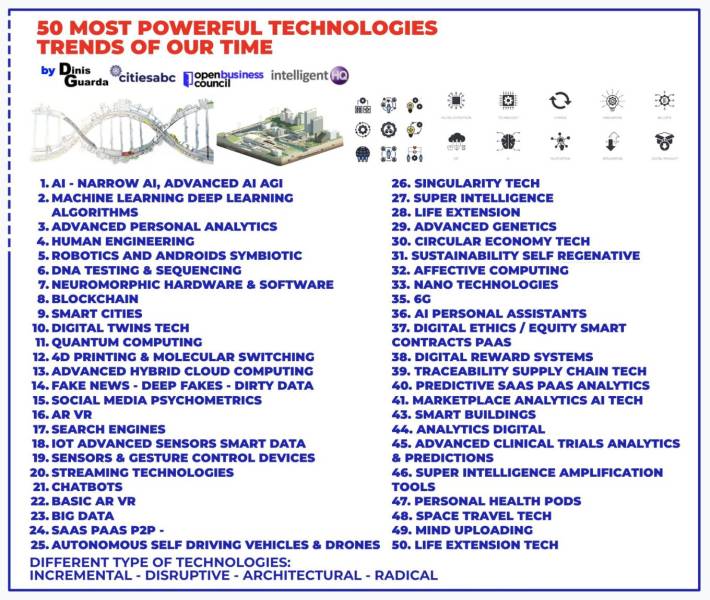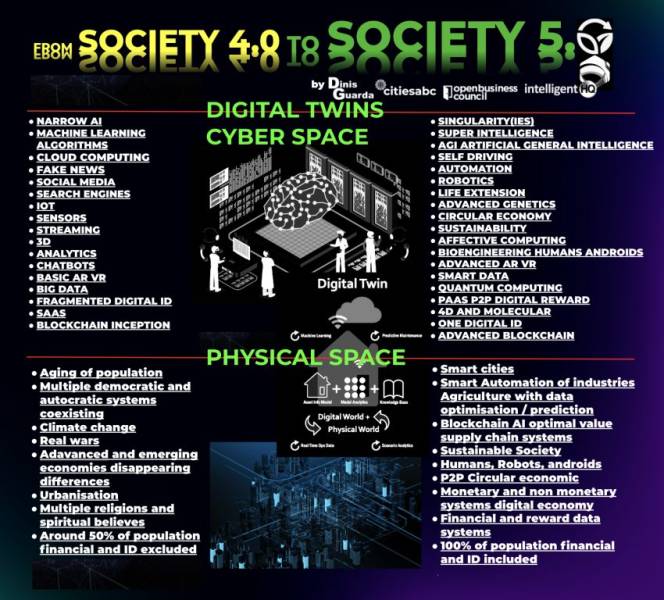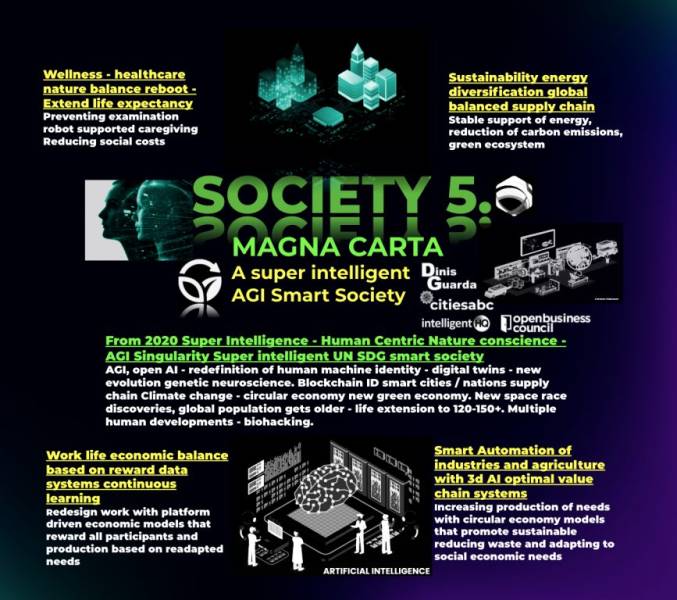“Everybody is a genius. But if you judge a fish by its ability to climb a tree, it will live its whole life believing that it is stupid.” — Albert Einstein
“Our technology, our machines, is part of our humanity. We created them to extend ourselves, and that is what is unique about human beings.” Ray Kurzweil

What are the most powerful technologies of our society 5.0 times? How can we cope with them? The concept of society 5.0 is a vision of a future human-centred society, nature where technology is used for the best possible outcomes. Society 5.0 is not about one single country or city. It is about humans, the planet and a balanced sustainable ecosystem.
As we speak Human society and intelligence is being vastly amplified, changed and augmented by AI. Even with our basic forms of narrow AI, we are already seeing the biggest disruption of human society with the manipulation of entire societies with social media, fake news and dark data. This is to add to our financial and capital markets that as we speak are all run by algorithms and deep learning/machine learning SAAS and PAAS.
We can define technology as the application of tools, and scientific knowledge for concrete practical uses, this happens in social aspects of our social life and especially in business and industry. When we speak about technology we tend to talk about “advances in technology, computing technology” and many forms of tools, machinery and equipment developed from the application of research, and invention and based on practical and scientific knowledge. The usage of technologies can and is normally used to solve a specific problem and reduce a society and its many sectors, the industry’s ability to use a solution to develop a tool and use a budget on a new technology or set of innovative tech.
Nowadays in Society 5.0, we tend to define technology as a set of tools and innovations we use in the branch of knowledge dealing with engineering or applied sciences put in practice for our society. Society 5.0 where we live has a large and complex global population. According to recent data from the United Nations (2019) the world’s population is expected to increase by 2 billion persons in the next 30 years, from 7.7 billion currently to 9.7 or over 10 billion in 2050. The same research estimates the world population in 2100 to be 10.9 billion. But the predictions vary according to different projections.
- Society 5.0 Magna Carta architecture, research infografic by Dinis Guarda
“Seventy thousand years ago, homo sapiens was still an insignificant animal minding its own business in a corner of Africa. In the following millennia, it transformed itself into the master of the entire planet and the terror of the ecosystem. Today it stands on the verge of becoming a god, poised to acquire not only eternal youth but also the divine abilities of creation and destruction.” Yuval Noah Harari
As we speak in our society we are building different types of technologies and innovations. Most of these iterations of our technology work and innovation can be perceived and processed in these categories:
• Incremental;
• Disruptive;
• Architectural;
• radical;
• Exponential.
But going forward the exponential disruptive technologies will be part of the acceleration that will shift humanity more in the next 50 years than in all the different stages of humanity. When we define exponential technology we tend to look at two things: the technology is exponential. And this technology or technologies in each period doubles in capability or performance. The second thing is this is a technology that is now at the point where its budget price-performance makes it possible to solve today’s society and business problems in ways that were not previously possible.
Exponential technologies and exponential growth are a pattern of data and technologies associated that demonstrates and offers greater ways to look at the increases of growth and tech power with the passing of time. Exponential technologies and exponential growth create the curve of an exponential function on society or specific ecosystem development. For example, if a population of animals such as mice doubles every year starting with two mices in the first year, the population would be four in the second year, 16 in the third year, 256 in the fourth year, and so on. The exponential growth concept shows and demonstrates the power of our present tech that will make radical changes in all areas of society and coming to the example of mices would show their population growing to the power of 2 each year in this case (i.e., exponentially).
As we apply exponential growth to all areas of technology it shows a pattern of data that shows sharper increases over time and opens a new direction in change and radical innovation and society. In health, cities, finance, exponential growth and technologies compounding create exponential growth and disruptive returns.
The increasingly more powerful exponential technologies of our time include artificial intelligence (AI) and all its different applications and foundational architectures. Another critical is blockchain, not just a technology on its own but as a concept and a set of applications and solutions from smart contracts to digital assets and provenance solutions. Finance and technologies – fintech is the biggest technology industry in the big digital and tech-driven world of finance, payments and banking. Other powerful technologies include quantum computing, augmented and many others such as virtual reality (AR, VR), data science, digital biology and biotech, medicine, nanotech and digital fabrication, networks and computing systems, robotics, and autonomous vehicles.
“Our intuition about the future is linear. But the reality of information technology is exponential, and that makes a profound difference. If I take 30 steps linearly, I get to 30. If I take 30 steps exponentially, I get to a billion.” Ray Kurzweil
“The race to obtain the data is already on, headed by data-giants such as Google, Facebook, Baidu and Tencent. So far, many of these giants seem to have adopted the business model of ‘attention merchants’. They capture our attention by providing us with free information, services and entertainment, and they then resell our attention to advertisers. Yet the data-giants probably aim far higher than any previous attention merchant. Their true business isn’t to sell advertisements at all. Rather, by capturing our attention they manage to accumulate immense amounts of data about us, which is worth more than any advertising revenue. We aren’t their customers – we are their product.
(…)
Leaders are thus trapped in a double bind. If they stay in the centre of power, they will have an extremely distorted vision of the world. If they venture to the margins, they will waste too much of their precious time. And the problem will only get worse. In the coming decades, the world will become even more complex than it is today. Individual humans – whether pawns or kings – will consequently know even less about the technological gadgets, the economic currents, and the political dynamics that shape the world. As Socrates observed more than 2,000 years ago, the best we can do under such conditions is to acknowledge our own individual ignorance.”
Yuval Noah Harari
These top 50 technologies are now run by organisations and corporations that are leading the world and controlling our social, health, financial, economic and data human resources.
The first constitutional treaty of our times was the Magna Carta. Magna Carta, the Latin word for “Great Charter” (literally “Great Paper”), also known as Magna Carta Libertatum, was an English 1215 document charter which limited the power of the than English Monarchs, specifically King John, from the absolute rule.
The Magna Carta document was the ultimate result of disagreements between the Pope and King John and his noble barons over the rights of the king. This document and treaty Magna Carta was drafted and written as a requirement to the king to find a balance and renounce certain rights and respect certain legal procedures. the document aimed to make the king accept that the will of the king could be bound by law. Magna Carta is still today highly important. Magna Carta is widely considered to be the first step in a long society historical process leading to the rule of building a social and documentation constitutional law.
To deal with all the present challenges of our society 5.0 and all the powerful technologies and companies that are managing them and that are changing our society like never before we need a new Society 5.0 Magna Carta architecture.


Dinis Guarda is an author, academic, influencer, serial entrepreneur, and leader in 4IR, AI, Fintech, digital transformation, and Blockchain. Dinis has created various companies such as Ztudium tech platform; founder of global digital platform directory openbusinesscouncil.org; digital transformation platform to empower, guide and index cities citiesabc.com and fashion technology platform fashionabc.org. He is also the publisher of intelligenthq.com, hedgethink.com and tradersdna.com. He has been working with the likes of UN / UNITAR, UNESCO, European Space Agency, Davos WEF, Philips, Saxo Bank, Mastercard, Barclays, and governments all over the world.
With over two decades of experience in international business, C-level positions, and digital transformation, Dinis has worked with new tech, cryptocurrencies, driven ICOs, regulation, compliance, and legal international processes, and has created a bank, and been involved in the inception of some of the top 100 digital currencies.
He creates and helps build ventures focused on global growth, 360 digital strategies, sustainable innovation, Blockchain, Fintech, AI and new emerging business models such as ICOs / tokenomics.
Dinis is the founder/CEO of ztudium that manages blocksdna / lifesdna. These products and platforms offer multiple AI P2P, fintech, blockchain, search engine and PaaS solutions in consumer wellness healthcare and life style with a global team of experts and universities.
He is the founder of coinsdna a new swiss regulated, Swiss based, institutional grade token and cryptocurrencies blockchain exchange. He is founder of DragonBloc a blockchain, AI, Fintech fund and co-founder of Freedomee project.
Dinis is the author of various books. He has published different books such “4IR AI Blockchain Fintech IoT Reinventing a Nation”, “How Businesses and Governments can Prosper with Fintech, Blockchain and AI?”, also the bigger case study and book (400 pages) “Blockchain, AI and Crypto Economics – The Next Tsunami?” last the “Tokenomics and ICOs – How to be good at the new digital world of finance / Crypto” was launched in 2018.
Some of the companies Dinis created or has been involved have reached over 1 USD billions in valuation. Dinis has advised and was responsible for some top financial organisations, 100 cryptocurrencies worldwide and Fortune 500 companies.
Dinis is involved as a strategist, board member and advisor with the payments, lifestyle, blockchain reward community app Glance technologies, for whom he built the blockchain messaging / payment / loyalty software Blockimpact, the seminal Hyperloop Transportations project, Kora, and blockchain cybersecurity Privus.
He is listed in various global fintech, blockchain, AI, social media industry top lists as an influencer in position top 10/20 within 100 rankings: such as Top People In Blockchain | Cointelegraph https://top.cointelegraph.com/ and https://cryptoweekly.co/100/ .
Between 2014 and 2015 he was involved in creating a fabbanking.com a digital bank between Asia and Africa as Chief Commercial Officer and Marketing Officer responsible for all legal, tech and business development. Between 2009 and 2010 he was the founder of one of the world first fintech, social trading platforms tradingfloor.com for Saxo Bank.
He is a shareholder of the fintech social money transfer app Moneymailme and math edutech gamification children’s app Gozoa.
He has been a lecturer at Copenhagen Business School, Groupe INSEEC/Monaco University and other leading world universities.













